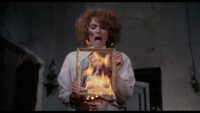Adapting Mary Shelley’s Frankenstein to the modern era, especially with a teenager in the title role, presents some unique tonal challenges, and although Bomani J. Story’s directorial debut doesn’t quite manage to master them, watching it wrestle with them is certainly compelling in its own right. I respect that they took the bolder course and chose to play it almost totally straight, even if I’m not convinced that was their best option. Shelley’s story was primitive as sci-fi goes and adaptations are going to have a hard time presenting a realistic version of the story, so most go for camp or lean into the Gothic extravagance. The Angry Black Girl and Her Monster plays it as straight as Frankenstein retellings get and adds to the fact its Victor Frankenstein, Vicaria, is a working class high-schooler (Laya DeLeon Hayes), making its premise even more far-fetched.
Science prodigy Vicaria is certainly credibly motivated to try and create life out of death. Surrounded by the effects of gang violence her whole life, when she loses her older brother Chris (Eden Atsu-Swanzy), she resolves to bring him back, repairing his decaying body in a condemned garage with parts salvaged from other local victims. It’s a dynamic and surprisingly gory retelling and the setting is a radical method of approach. With a teenage protagonist those expecting more of a youth-friendly approach might be taken aback by the violence and forcefulness of the retelling.
Sometimes this very aspect creates some blowback. A lot of the interpersonal conflict between Vicaria and supporting characters—to which a surprising amount of the films runtime is devoted—feels a little excessive and haphazard. Perhaps it serves to place the drama in a somewhat heightened reality, as it certainly is, but it is an ambitiously nuanced tone to attempt for a first feature and it can come off a little awkwardly at times.
This is little due to the performances of the cast through, all of which are notably strong in their characterization and commitment. As the young lead, DeLeon Hayes takes much of the spotlight, managing to capture the headstrong protagonist’s tunnel vision and frustration, which the script firmly roots in her sense of loss and survivor’s guilt. She lost her mother and brother to the streets and now she’s losing her father to drugs too. Seemingly unable to avert a future that seems inevitable, she turns to audacious attempts to turn back the past. But, when Chris’s cadaver does rise from the gurney, he’s too far gone down the monstrous path his life was setting him on. He cuts a potentially iconic figure, his dreadlocks dangling from his hooded head, face an indistinguishable mess of scarring and decay, his presence is often more akin to a workaday slasher movie antagonist than Shelley’s tragic antihero.

Moving the story’s setting to the modern inner city places it more at risk of falling into Hood Movie clichés than those of Gothic horror but its attempts to capture the voice of its environment and its inhabitants are credible and rewarding. Some of the films best scenes are devoted to building Vicaria’s rapport with her late mother’s extended family, time invested that plays off extremely well in the film’s emotional climax. With his spiraling drug addiction, Vicaria’s father Donald (Chad L. Coleman) could have been a reductive stereotype, but the film avoids this, instead characterizing him as a proud, devoted and supporting father whose oppressive work schedule and recent bereavement have driven him to substance dependency. Another of the film’s standout performances comes from Amani Summer as young Jada, Vicaria’s cousin, another reminder that horror has long been a breeding ground for child acting talent.
The film’s budget may have been limited, as is occasionally evident, but it manages to create a fair amount of atmosphere thanks to some surprisingly effective effects work and shocking violence. It has a lot of story to balance and though it does spread itself a bit thin, especially for its ninety minute runtime, its impressive how well it does manage to marry the classic concept to the radical modern setting, however unnatural a match-up it is. The title The Angry Black Girl and Her Monster may imply it’s more preoccupied by the icons of its story than its characters, but in fact, its commitment to the emotional intensity of its story is as rewarding as it is faithful to the spirit of the original Gothic source material.



